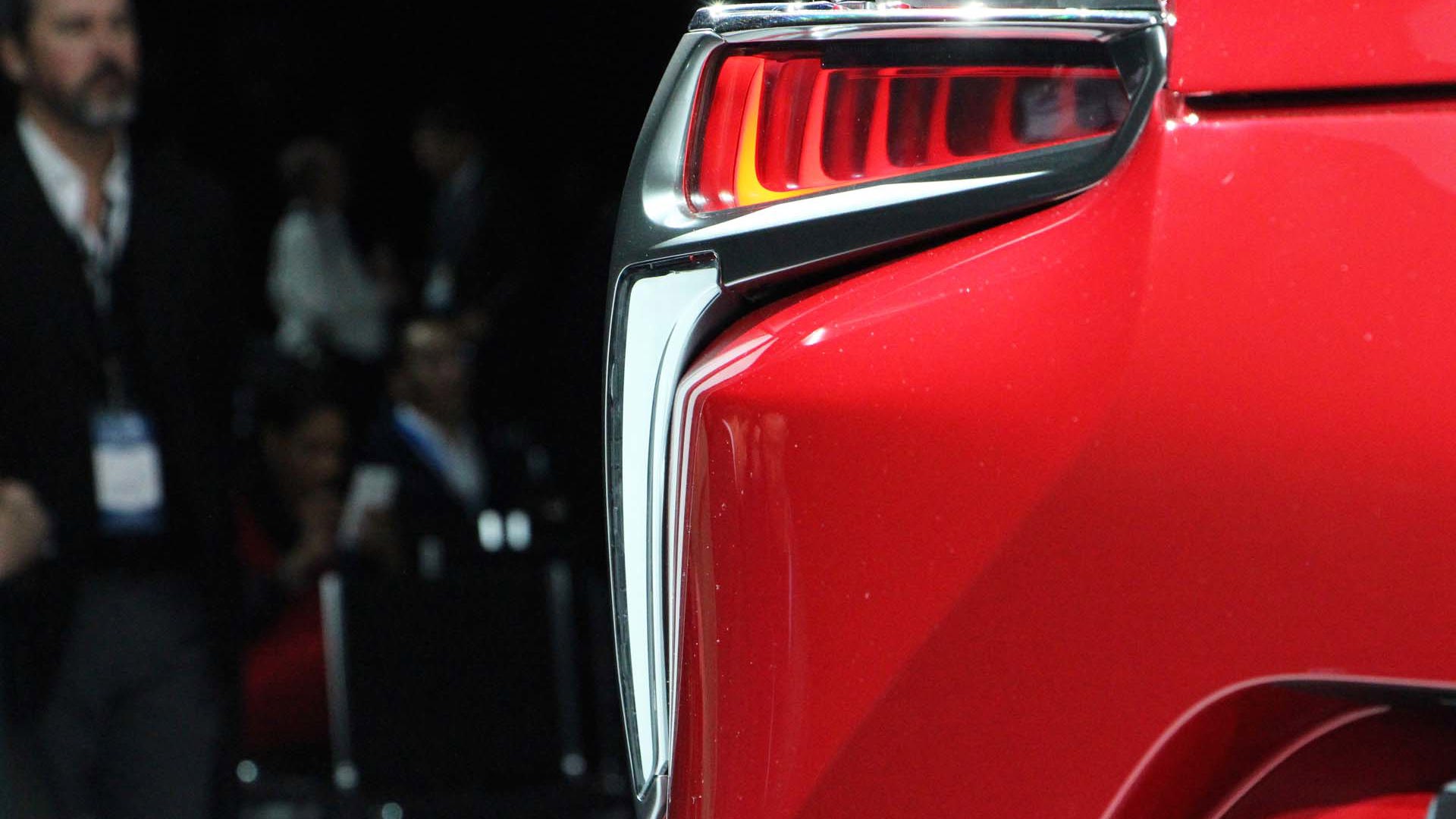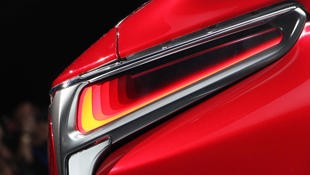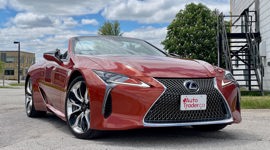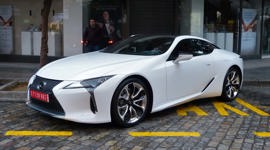Motive, means, and opportunity.
At this year’s North American International Auto Show, Lexus drove two cars onto the stage as CEO and Master Test Driver Akio Toyoda gave a passionate speech about his burning desire to make the Lexus brand desirable and seductive. While Lexus sales struggled along with the economy, they have rebounded almost as well as their German rivals in North America, so it’s not strictly necessary for them to reinvent the brand as Acura, Lincoln and Infiniti seem to every few years. No, this is a legacy play. Toyoda wants to stamp his legacy on the Lexus brand and make it every bit the revered marque as the Germans. Just as Audi created a car worthy of posters on an adolescent’s wall, yet still attainable in the luxury coupe market as in the R8, Lexus has followed the LFA supercar with a car that will be accessible to far more customers, yet radiates exclusivity and lust, and will stand out from the crowd with its looks.
“We decided that we want to realize the LF-LC into production as a production car.”
This project didn’t just show up overnight, however. Four years prior, behind closed doors at the 2011 Pebble Beach Concours D’elegance, Akio Toyoda met with some leading automotive journalists, and had something of a power-focus-group session about the Lexus brand and identity. The words “boring” and “bland” inflicted a painful realization, driven home no doubt by Lexus’s worst sales year in at least a decade in 2011 while Mercedes-Benz and BMW were rebounding nicely, both eclipsing Lexus in US sales. Then at the 2012 Detroit show, Lexus presented a daring LF-LC coupe concept, a design exercise that had journalists and showgoers drooling and applauding, but which Lexus had no intention of producing. Toyoda went home with a determination to change perception of the Lexus brand, and the concept to effect that reinvention.
We spoke with Koji Sato, Lexus Chief Engineer, about how the LC 500 had the potential to elevate the Lexus brand: “Creating the LF-LC into a production car has big meaning for the Lexus brand. After Pebble Beach 2011, Akio Toyoda believes that Lexus needs some changes. We wanted to move the brand in a more emotional direction. That’s the background on our feelings and the atmosphere of the whole team at Lexus. Therefore, we decided that we want to realize the LF-LC into production as a production car.”
Sato was tasked with delivering not just a production car loosely based or inspired by this concept, but essentially engineering this concept as a road-going vehicle. His reaction: “It’s a very tough job. We know the LF-LC… it’s fantastic. I like the car… so I think that one is really nice for me. I want to make it real. But on the other hand, it’s very difficult.”
Difficult indeed. To achieve this true-to-concept production version of the LF-LC, Lexus pioneered a new approach of “heightened collaboration” between design and engineering teams during the development process, and we were lucky enough to speak to Lead Designer Tadao Mori at the same time, both of whom share a refined design sensibility, naming the Toyota 2000GT and early Ferraris (Sato the Dino 246 and Mori the 250 GT SWB) as personal design favourites. What rolled out on stage in Detroit was a fairly definitive proof of concept.
At first glance, both vehicles on the Lexus stage seemed like concept cars, even though one of them was truly a production model that will arrive on the market later this year. The concept was the LF-FC first seen in Tokyo last fall, hypothetically hydrogen-fuel-cell powered and dramatically styled with curves and angles evolving Lexus’s design language to flow from that polarizing and dominating spindle grille. After the LF-LC took its place to the back, Lexus rolled out a slinky coupe that will be dubbed the LC 500, launching the LC flagship coupe line, a classic front-engine, rear-drive, two-door four-seat, grand touring layout, but with styling that puts in squarely in the 21st century, and quite possibly in future museum displays about the high points of automotive design.
Examine the LC 500’s exterior, and you find details like the intriguing shape of the taillight housing calling to mind the F-sport logo, the layered lighting effect of the taillights, the complex shape of the headlights and DRLs, the exhaust the roofline and profile and the complex curves and recessed surfaces of the body panels, all matching the LF-LC concept in effect within the scope of production capabilities. Even the wheels are virtually identical, helping to maintain the extreme and dramatic proportions of the concept. In the case of the grille itself, Lead Designer Mori took it a step further, introducing a 3-D mesh design that splits into a multi-layered lattice.
While the LC 500’s exterior is close enough to concept to be considered a doppelgänger, the interior had to take a far different path as it could not hope to match the floating seats, spectacular gauge cluster and futuristic screens and interfaces imagined for a car of the far more distant future. Instead, the interior is a more familiar Lexus cabin, taken to the next level, Mori citing the cabin materials as the element that raise this car’s and the brand’s luxury pedigree. They didn’t just pick the leather out of the old parts bin, of course, they went the extra distance; “We work together with a colour and trim designer, they brought us nice samples so we can touch and feel and put on the clay model,” explains Mori, “We can see the differences, which is better – skin shape, touch and feel, those kinds of things.”
We couldn’t take our time and leisure sitting ensconced in the Alcantara and leather seats (we weren’t allowed to sit in it), what we did sample should equal the finest Germany has to offer, and subtle touches like the wavy ridges on the Alcantara door panel insert and centre-console buttress try to evoke the spirit of the concept even if it could not deliver the same wild foray into the future of automotive interiors. (Do not look at pictures of the concept’s gauge cluster – you’ll cry that they couldn’t give us something that radical.)
Then again, the interior of the LC was not focused on a single feature or technology. “We didn’t want just functionality, we didn’t want just high-spec and high-tech,” Mori added. “We want to envelop that kind of stuff with a nice, elegant style.” The end result is an interior that still maintains some of Lexus’s reserved personality, but in rich, creamy tan colours and materials, escapes the sobriety of an all-black, business-only cabin, while seamlessly integrating Lexus’s latest touchpad interface and LFA-inspired adaptive gauge cluster.
However, the interior was not the greatest challenge presented to the LC 500’s development team. Sato explains, “For me the biggest challenge is creating the Lexus driving taste. The Lexus is a nice car in comfort and high quality, but sometimes we heard the voice of the customer that Lexus has no character. Our biggest challenge is creating our character. Our keyword is more sharper, more elegant. Elegant is one of the ideas for the Lexus DNA that we don’t want to lose, that character. But on top of that, we want to have a more sharper, more precise driving taste that we want to create. That is the biggest challenge for me.”
In that vein, Lexus took the classic formula of the front-engine, rear-drive grand tourer, but pushed it to the very limits
The chassis is an entirely new architecture (GA-L), destined to underpin the flagship LS sedan to follow and perhaps other large, premium vehicles. For this application, the focus was keeping the centre of mass lower and centred, with precise application of high-strength steel, a carbon-fibre roof, aluminum door skins wrapped around carbon-fibre door structures, and the V8 mounted behind the front axle and battery in the trunk for better balance, which was meticulously controlled to achieve a 52/48 front/rear weight distribution. The high-strength steel and carbon-fibre components are supported by aluminum front suspension towers and control arms and a ring structure in the rear that also contribute to an unprecedented level of torsional rigidity, surpassing even the LFA supercar, which allow for both greater range in suspension tuning and sharper steering responses.
The naturally aspirated V8 is a bit of an anachronism as nearly every luxury performance machine is moving to forced aspiration, but it was readily available and already tuned to please and entertain in the RC F and GS F. The LC 500 team chose it for its engaging character, to which we can testify based on our experience in the RC F, which was the first car to harness this 5.0L V8 to its full potential, and here again Lexus aims to deliver 467 hp and 389 lb-ft of torque, and a steady, natural power curve. Sato explains, “We wanted to create a more natural vehicle behaviour… and you also have smooth acceleration, even at a higher rpm range.” Power delivery is all natural, and the all-aluminum V8 with high-strength forged connecting rods and titanium valves allow the engine to peak at high rpm while the dual intake inlets help it breathe and contribute to its aural signature. On the exhaust side, sound-control valves open during start-up to give it a barking mad introduction, but we are disappointed that Lexus has resorted to a “Sound Generator” to enhance the engine’s natural voice. As with so many others, we’re sure it will sound good, and likely will not be able to tell the difference, but the desire for authenticity remains.
Converting the power into forward motion is an all-new 10-speed transmission Lexus developed, with shift times claimed to rival dual-clutch gearboxes, and we expect all of the typical smoothness of Lexus transmissions. With so many gears, closely packed low gears allow for robust acceleration while optimizing highway efficiency in the higher gears, but we can’t help but wonder if the transmission will be able to keep up with drastic changes in speed braking for corners that will require multiple gear swaps to keep the engine in its sweet spot.
Along with carefully crafted throttle response, freshly optimized electronic controls, big stonking wheels (Michelin Sport tires: 245/40RF21 up front and 275/35RF21 at the rear) providing ample contact patches, Lexus expects the LC 500 will launch to 60 mph in about 4.5 seconds.
Lexus set ambitious dynamic and performance goals for this car, and while it might be lost on your typical ES 350 shopper, carving out a niche in the $100K+ luxury coupe segment requires identity above all else, but performance is a prerequisite. This was one of Sato’s key missions: “If you think about the luxury coupe segment, the BMW 6 Series, Jaguar F-Type, Maserati GT, Porsche 911, all these kinds of cars have some uniqueness. In all these cars, the driving pleasure is very high. People who want to buy a luxury coupe want it to have some uniqueness and also high driving performance. It’s called a luxury coupe, but at the same time they want to have high-performance driving pleasure.” Well, if Sato and Mori managed to deliver the looks and sounds of the Jag, the seductiveness of the Maserati and the control of the 911, they’ll certainly have a winner on their hands.
And in this segment, the performance model is also a prerequisite, so an LC F will be sure to follow to compete with the like of M6, SL 63 AMG, 911 Turbo and the recently announced F-Type SVR. The question is, where will Lexus turn for their next level of power: Toyota’s longstanding experience with hybrid-electric motivation, or their newly adopted range of turbos? Sato wouldn’t tip his hand, but he keeps a 1993 Supra in his garage as his personal toy, and the one thing he would say is: “I love that big turbo.”


















































